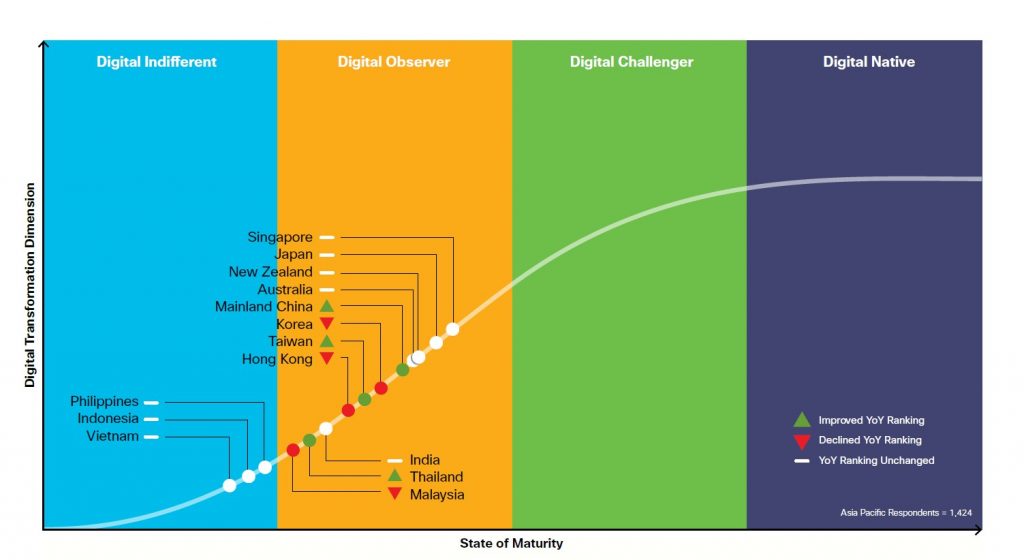3 Most Common Barriers for SMEs implementing Digital Transformation

Digital transformation (DX) is challenging enough for corporates with scale-appropriate budgets. The complexity of technology integration, the stakeholder hills to climb, and the constant push-pull between market-driven needs and operational stability make any digital transformation agenda exasperating.
But when it comes to small and medium businesses without abundant resources that match up to their visions, the barriers are multi-fold.
The joint 2020 SME Digital Transformation Study by Microsoft Singapore and the Association of Small & Medium Enterprises (ASME) revealed that while 83% of small and medium enterprises (SMEs) in Singapore now have digital transformation strategies in place, more than half reported delays in their digitalisation plans due to COVID-19. Despite higher adoption of digital transformation, only two in five SMEs perceive their efforts to be successful.

Figure 1 Digital Maturity of SMBs in Asia Pacific
Image source: 2020 Asia Pacific SMB Digital Maturity Study
Cisco’s Asia Pacific SME Digital Maturity study indicates that though Singapore topped the maturity index, it was still at the second of four stages of digital transformation, namely “digital observers”. Participating SMEs reported that many of their processes are still not automated and that they are focused on addressing inefficiencies with very limited use of analytics, focused on the use of reporting tools and only starting to create a digital plan.
In this article, we discuss three of the most common barriers encountered by SMEs on their digital transformation journeys:
1. Resource Complexity: Cost, Time, Talent.
The primary barrier hindering holistic digital transformation at SMEs is of course the budgets that they are able to carve out for it.
Typical DX implementations include upgrading legacy systems to modern applications for all users, migrating to the cloud, automating business processes, ensuring accurate integration and flow of data between all components, and, importantly for SMEs, designing customer-centric workflows. Effective implementation requires a complex collaboration across organisational structures and procurement of several tools and technologies. This can be a daunting investment for SMEs.
Not to mention the time spent getting used to the new systems. Digitalisation is little good without strong, clean data – which needs time and attention to first set up and then maintain. But time is always a scarce resource for SMEs. Time spent on administrative tasks is time lost for lead nurturing or sales outreach. Ask any SME leader – lost business is a scarier scenario than lost productivity.
Implementation costs also include those of hiring specialist skillsets, which are at a premium these days.
Hybrid cloud infrastructure needs experienced cloud specialists, network architects and cybersecurity experts. RPA implementations need software developers and data engineers to ensure proper process orchestration. Tech experts need to be change agents and business experts need to understand the full technology stack.

According to the 2022 Robert Walters Salary Survey, 85% of Singapore firms in the tech and transformation industry are giving the highest pay raises among the seven sectors surveyed.
Singapore is known to have a mismatch in the supply and demand of technology workers, and restrictions on hiring foreign talent don’t help matters much. For context: Singaporeans make up just over a third of the estimated 25,000 tech workers in the local financial sector. These kinds of demographics make for costly local DX hiring.
Singapore offers financial support and upskilling for SMEs.
- CTO-as-a-Service
- Digital Consultancy Services (including Digital Advisory and Project Management)
- Digital Acceleration Index (DAI) Assessment
- Better Data Driven Business Programme (including a Business Intelligence Tool)
- InvoiceNow (nationwide E-invoicing method)
- Training at SkillsFuture Singapore (SSG)-appointed Continuing Education and Training (CET) Centres
- Data Protection Essentials for SMEs
- Digital Leaders Programme (DLP)
- SMEs Go Digital programme
- Grow Digital
- Industry Digital Plans
- Hawkers Go Digital
- Accreditation@SGD
- Open Innovation Platform
- SG:D SPARK
- SME Digital Tech Hub
- Small Business Recovery Grant
- Productivity Solutions Grant
- Advanced Digital Solutions (ADS) scheme
- Training Initiatives such as the SkillsFuture Career Transition Programme, SGUnited MidCareer Pathways Programme, TechSkills Accelerator, SkillsFuture Enterprise Credit.
2. Cultural Change Management
Like any other company-wide project, digital transformation affects all departments, roles and stakeholders, and has a significant change management component. DX challenges the status quo and in more close-knit SME communities even challenges organisational identity.
Many SMEs go the route of business process automation and/or cloud migration as their digital transformation pathway. SMEs pride themselves on providing their employees with autonomy to be agile and responsive, so reallocating time spent on mundane repetitive tasks towards customer-focused activities is the low-hanging fruit in a complex DX roadmap.
When teams have spent years building and optimising inter-dependencies and multi-channel workflows to serve their customers and grow the business, a sudden technology implementation is likely to generate more stress rather than it releases. Workflow misalignment has a direct impact on collaboration and competitiveness. Imagine orders not being processed, errors thrown by customer transactions, or worse – teams not communicating with each other. Even worse – an operational oversight causing a cybersecurity incident.
Change management, and particularly cultural change management, cannot be emphasized enough. Unfortunately, it is often cited as the number one reason that digital transformation projects fail.

It’s important to remember that DX is beyond technology. It is beyond productivity and efficiency. It is not about modernising for the sake of participating in the modern age.
Digital transformation is about fostering collaboration and innovation. Transforming your company’s way of working takes it from a state of just existing to a state of continuously excelling. DX helps you become comfortable with change rather than spending valuable time and resources catching up to it.
Infusing this mindset into the culture of the company undergoing DX is critical. Every stakeholder needs to be engaged in not only the implementation but also in the overarching vision. A thorough definition of roles and responsibilities gives visibility to new synergies and promotes a sense of ownership.
According to BCG, culture is key in transformation, and senior leaders must create a strong digital culture: A digital culture empowers people to deliver results faster. A digital culture attracts and retains better talent. Organisations that ignore culture risk transformation failure.
3. Cybersecurity Risks
We’ve said it before, and we’ll say it again: our increasingly digitalised world is the cybercriminal’s oyster.
The Cyber Security Agency of Singapore (CSA) notes in its 2020 Singapore Cyber Landscape (SCL) that attacks involving ransomware, malicious command and control (C&C) servers and botnet drones have increased drastically, and phishing, website defacements and cybercrime continue to plague the region. The ransomware threat is growing into a systemic problem, with threat actors exploiting loopholes in business processes and interdependencies – a prevalent risk for SMEs. Ransomware attacks will continue to evolve, remote workers will be targeted, and supply chains will be disrupted. Small and medium businesses (SMEs) are not exempt.
Threat actors are no longer targeting just large corporates – they know that SMEs have more reputation to lose and less muscle to negotiate with. They are “soft” targets.
In their report, Critical Watch Report: SME Threatscape 2019, managed detection and response (MDR) provider Alert Logic reveals that 58% of malware attack victims are small businesses and that 94% of attacks come through malware or phishing emails disguised as bills, invoices, email delivery failure notices and package delivery notifications. They also share that there is a steady increase in new attack methods that target weaknesses in encryption, workload configuration, limited visibility into vulnerabilities, and outdated and unsupported operating systems at small businesses.

When digital transformation is driving the rapid adoption of new technologies, it becomes easy to open up vulnerabilities without realising the risks. Any cloud infrastructure or any new ERP system brings with it a number of new endpoints. The multitude of technology integrations require connections to company logins.
Gartner notes in its paper “Top Priorities for IT: Leadership Vision for 2021” that acceleration in digital business is outstripping cybersecurity investment.
With business models evolving, and more partners and touchpoints being introduced in any given ecosystem, businesses, as well as IT leaders, need to reinforce cybersecurity collaboration across all roles. Legacy security infrastructure was not designed for the digital acceleration and cyber risks of today.
While cybersecurity may not be a ‘perceived’ barrier that is stopping or slowing digital transformation for SMEs, it is certainly a risk that will upend it if not managed well.
To conclude, there are many perceived and actual barriers to digital transformation, but, if done right, the benefits far outweigh them. Digital transformation journeys unlock both financial and intangible value in the form of TCO reduction (total cost of ownership), scalability, innovation, and more.
All you need is the right technology partner!



















